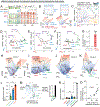An approximate line attractor in the hypothalamus encodes an aggressive state
- PMID: 36608653
- PMCID: PMC9990527
- DOI: 10.1016/j.cell.2022.11.027
An approximate line attractor in the hypothalamus encodes an aggressive state
Abstract
The hypothalamus regulates innate social behaviors, including mating and aggression. These behaviors can be evoked by optogenetic stimulation of specific neuronal subpopulations within MPOA and VMHvl, respectively. Here, we perform dynamical systems modeling of population neuronal activity in these nuclei during social behaviors. In VMHvl, unsupervised analysis identified a dominant dimension of neural activity with a large time constant (>50 s), generating an approximate line attractor in neural state space. Progression of the neural trajectory along this attractor was correlated with an escalation of agonistic behavior, suggesting that it may encode a scalable state of aggressiveness. Consistent with this, individual differences in the magnitude of the integration dimension time constant were strongly correlated with differences in aggressiveness. In contrast, approximate line attractors were not observed in MPOA during mating; instead, neurons with fast dynamics were tuned to specific actions. Thus, different hypothalamic nuclei employ distinct neural population codes to represent similar social behaviors.
Keywords: MPOA; VMH; aggression; calcium imaging; courtship; dynamical systems; hypothalamus; innate behavior; line attractor; rSLDS.
Copyright © 2022 The Authors. Published by Elsevier Inc. All rights reserved.
Conflict of interest statement
Declaration of interests The authors declare no competing interests.
Figures






References
-
- Paredes RG, and Baum MJ (1997). Role of the medial preoptic area/anterior hypothalamus in the control of masculine sexual behavior. Annu Rev Sex Res 8, 68–101. - PubMed
-
- Canteras NS. (2002). The medial hypothalamic defensive system: hodological organization and functional implications. Pharmacology Biochemistry and Behavior 71, 481–491. - PubMed
Publication types
MeSH terms
Grants and funding
LinkOut - more resources
Full Text Sources
Molecular Biology Databases

